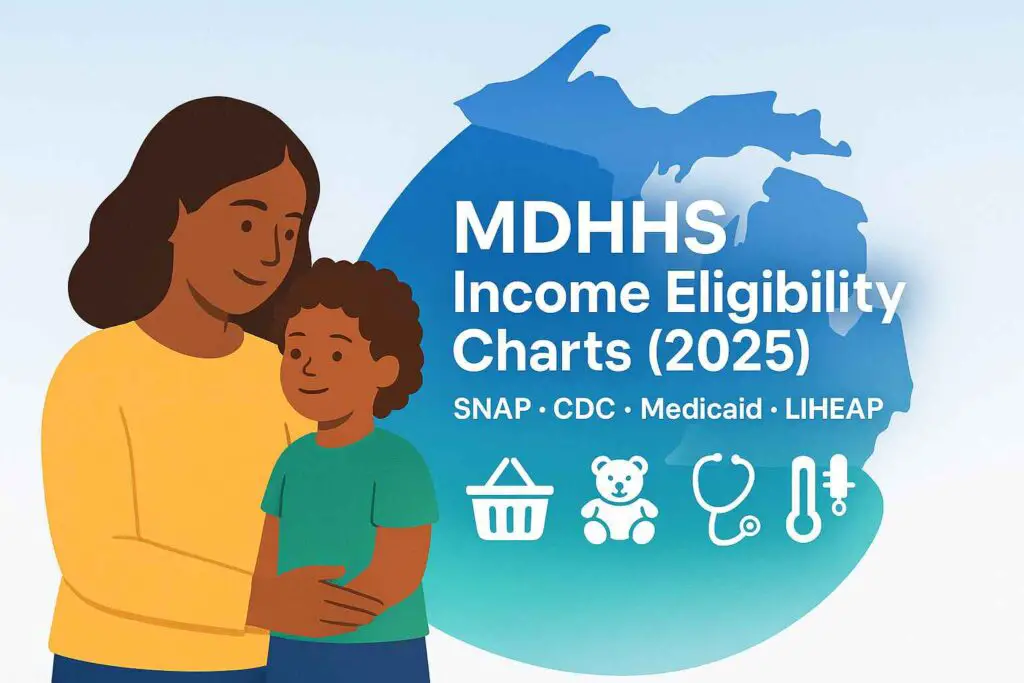In today’s complex socio-economic landscape, the Michigan Department of Health and Human Services (MDHHS) plays a pivotal role in providing crucial assistance programs to support vulnerable populations. This article explains the significance of income eligibility charts within MDHHS programs, guiding you through eligibility criteria for childcare support, food assistance, healthcare coverage, and energy bill assistance. Whether you’re applying for a DHS car voucher or seeking monthly benefits, income eligibility charts form the cornerstone of access to MDHHS programs.
Updated: January 2025 – These MDHHS income eligibility charts are based on the latest federal poverty guidelines and Michigan DHS updates.
Jump to Section:
The Significance of Income Eligibility Charts
Income eligibility charts act as a guiding compass for determining who qualifies for MDHHS assistance programs. These charts are designed to ensure a fair distribution of benefits by defining clear income thresholds. By adhering to these limits, MDHHS guarantees that assistance reaches those who need it the most.
The accuracy and currency of these charts are critical. Changes in economic conditions and living costs necessitate periodic updates. This ensures that the programs effectively serve their intended purpose of supporting low-income individuals and families.
Overview of MDHHS Assistance Programs
MDHHS offers a wide range of programs tailored to diverse needs. From child care to food security, the department’s programs strive to uplift the quality of life for Michigan residents. Below are the most commonly used programs along with income chart details.
SNAP (Food Assistance Program) Income Eligibility Chart – Michigan (FY 2025)
Effective Oct 1, 2024 – Sept 30, 2025
| Household Size | Gross Income Limit (200% FPL) | Net Income Limit (100% FPL) | Gross Income Limit (130% FPL) applies only to some non-S/D/V households |
|---|---|---|---|
| 1 | $2,510 | $1,255 | $1,632 |
| 2 | $3,408 | $1,704 | $2,215 |
| 3 | $4,304 | $2,152 | $2,798 |
| 4 | $5,200 | $2,600 | $3,380 |
| 5 | $6,098 | $3,049 | $3,963 |
| 6 | $6,994 | $3,497 | $4,546 |
| 7 | $7,890 | $3,945 | $5,129 |
| 8 | $8,788 | $4,394 | $5,712 |
| Each add’l person | + $898 | + $449 | + $583 |
Notes: Most MI households qualify under the 200% FPL gross test (broad-based categorical eligibility). Net income = after allowed deductions. Some households without a senior/disabled/veteran member may still be subject to the 130% gross test. Always see official MDHHS guidance for specifics.
Child Development & Care (CDC) Income Eligibility – Michigan
Income Eligibility Scale effective Sept 22, 2024
| Family Size | Entry (Max Monthly Gross Income) | Exit (Max Monthly Gross Income) |
|---|---|---|
| 1 | $1,255 | $4,114 |
| 2 | $1,703 | $5,380 |
| 3 | $2,152 | $6,646 |
| 4 | $2,600 | $7,912 |
| 5 | $3,048 | $9,178 |
| 6 | $3,497 | $10,444 |
| 7 | $3,945 | $10,681 |
| 8 | $4,393 | $10,919 |
How it works: At application, family income must be at/below the Entry amount for your family size. After approval, ongoing eligibility ends if income rises above the Exit amount (unless deemed temporary excess income). CDC also assigns a Family Contribution (FC) per pay period based on income tier.
Medicaid Income Eligibility – Michigan (2025)
Effective January 2025 (Aged, Blind, Disabled programs – institutional care)
| Category | Monthly Income Limit | Asset Limit | Notes |
|---|---|---|---|
| Single Applicant (Nursing Home / Waiver) | $2,829 | $2,000 | All income above limit may be applied toward cost of care. |
| Married (Both Applying) | $5,658 combined | $3,000 combined | Community Spouse protections may apply. |
| Community Spouse Resource Allowance | — | Up to $154,140 | Spouse at home can keep this amount in countable assets. |
| Monthly Maintenance Needs Allowance (Spouse at Home) | $2,555 – $3,853 | — | Range depends on housing and living costs. |
Note: Medicaid has multiple categories (pregnant women, children, expansion adults, ABD, etc.) each with different income rules. Above table is for seniors and disabled adults needing long-term care. Always confirm with MDHHS.
LIHEAP Income Eligibility – Michigan (2025)
Based on 150% of Federal Poverty Level (FPL) – effective October 1, 2024 – September 30, 2025
| Household Size | Maximum Annual Income | Approx. Monthly Income |
|---|---|---|
| 1 | $21,870 | $1,823 |
| 2 | $29,580 | $2,465 |
| 3 | $37,290 | $3,107 |
| 4 | $45,000 | $3,750 |
| 5 | $52,710 | $4,393 |
| 6 | $60,420 | $5,035 |
| 7 | $68,130 | $5,678 |
| 8 | $75,840 | $6,320 |
| Each add’l person | + $7,710 | + $643 |
Note: LIHEAP is federally funded but administered by Michigan. Eligibility is based on household size and gross income at or below 150% FPL.
Frequently Asked Questions (FAQs)
What is an income eligibility chart?
An income eligibility chart outlines the maximum income a household can have to qualify for specific MDHHS programs.
How do charts vary between MDHHS programs?
Each program has unique criteria. SNAP uses gross and net income tests, CDC has entry and exit levels, Medicaid varies by category, and LIHEAP is based on 150% of the Federal Poverty Level.
Can eligibility be determined solely by income?
Not always. Programs may also consider factors like disability status, household size, or medical needs.
Are these charts updated?
Yes, MDHHS updates charts periodically to reflect inflation and changes in federal poverty guidelines.
Where can I find the latest income eligibility charts?
The most accurate and up-to-date information is available on the official MDHHS website.
Conclusion
MDHHS income eligibility charts are the foundation for accessing essential assistance programs. By clearly outlining income thresholds, they ensure fairness and direct benefits to those in need. Staying informed about updates can help Michigan residents secure childcare, food, healthcare, energy aid, or even apply for a DHS car voucher. For official updates, always refer to the MDHHS website.
Additional Resources







